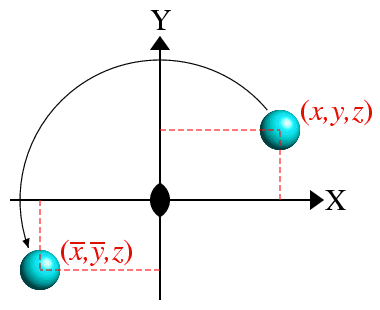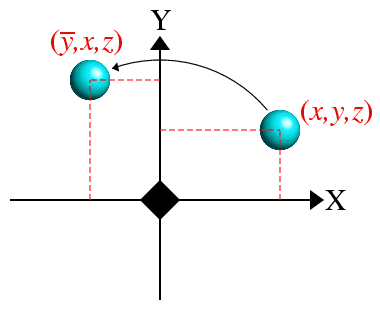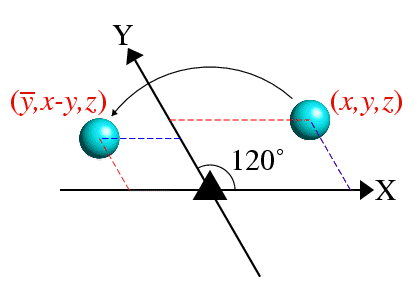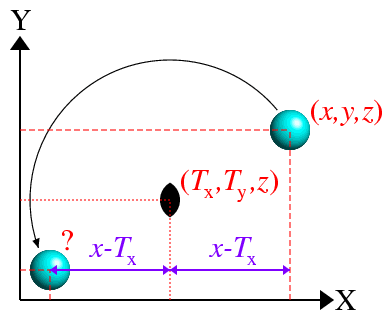 |
Rotational Symmetry
II. Symmetry Operators |
 |
Rotational Symmetry
II. Symmetry Operators |
Symmetry Operators
Given the atomic coordinates of a molecule in a crystal structure, it is often necessary to know the coordinates of the atoms of symmetry-related molecules. In order to do this, it is necessary to know how the (x,y,z) coordinates of the atoms in the first molecule relate to the atoms in the second. Symmetry operators can transform the coordinates of one molecule to those of another. This section explains the form of these symmetry operators for pure rotational symmetry.
Consider a twofold rotation axis parallel to the Z-direction (of a right-handed
conventional Cartesian system of axes) and passing through
the point (0,0,0), i.e. the origin,
and an atom with coordinates (x,y,z)
as shown below:

The symmetry operator for a twofold rotation through the origin may seem a little obvious. If so, what is the symmetry operator for a twofold rotation about the Y axis?
Consider now the case of a fourfold rotation
axis about the Z axis as shown below:

To see this consider an atom with coordinates (2,1,5) that rotates to the position (-1,2,5) under the action of the fourfold rotation. The new x-coordinate value (-1) is equal to the negative of the untransformed y coordinate value (+1), while the new y-coordinate value (+2) is equal to the positive value of the untransformed x coordinate (+2). Thus the symmetry operator for a positive fourfold rotation about the Z axis is not -x,y,z, but -y,x,z.
![]() What is the symmetry operator for a negative
fourfold rotation about the Z axis?
What is the symmetry operator for a negative
fourfold rotation about the Z axis?
The next figure shows the operation of threefold symmetry on an atom.
You will immediately observe that the coordinate system
is no longer Cartesian.
For threefold (and also sixfold) symmetry,
crystallographers usually choose a set of axes so that the angle between the
X and Y directions is 120° (= 360°/3),
with the Z direction perpendicular to
both X and Y. What is the reason for this?

Using the above axis system, the expression for a positive sixfold rotation is equally simple and takes the form (x-y,x,z).
Whereas most crystallographers can readily remember (or deduce) symmetry operators for twofold and fourfold rotations, the expressions for threefold (and sixfold) are not so easy to remember. However, crystallographers are not required to remember them all since they have been extensively tabulated for different crystal systems, both in books, CD-ROM, and in most of the modern crystallographic computer software.
The above examples of symmetry operators all refer to symmetry
axes that pass through the origin (0,0,0) of coordinate space.
Normally this is the case for high symmetry axes. However, it is very common
for twofold axes in a crystal not to pass through the origin as will be
demonstrated later.
The question then arises as to the form of the symmetry operator
for an axis not passing through the origin as illustrated in the figure below:

Applying a similar argument to the y-coordinate, one can show that
the coordinates of the atom after the symmetry operation are
![]() What is the symmetry operator for a twofold rotation axis parallel to X
and passing through the point (x,1/4,1/4)?
What is the symmetry operator for a twofold rotation axis parallel to X
and passing through the point (x,1/4,1/4)?
Finally, you may have noticed that no symmetry operators have been given for, say, a fivefold rotation axis. Although rotation axes of order, for example, 5, 7, 9, etc., do exist, they cannot exist as part of the long-range symmetry exhibited by a crystal lattice. This limits the number of types of rotation axes that crystallographers need to consider to 2, 3, 4, and 6, as will be shown in the section on translational symmetry.
| © Copyright 1995-2006. Birkbeck College, University of London. | Author(s): Jeremy Karl Cockcroft |